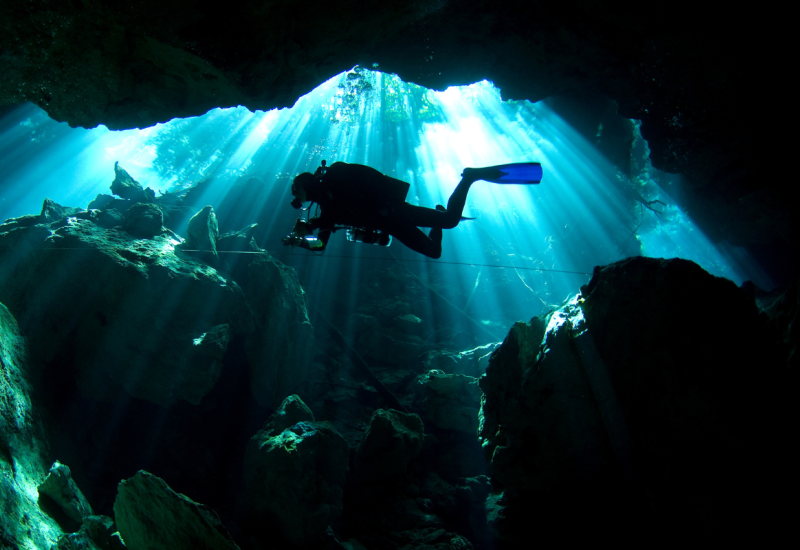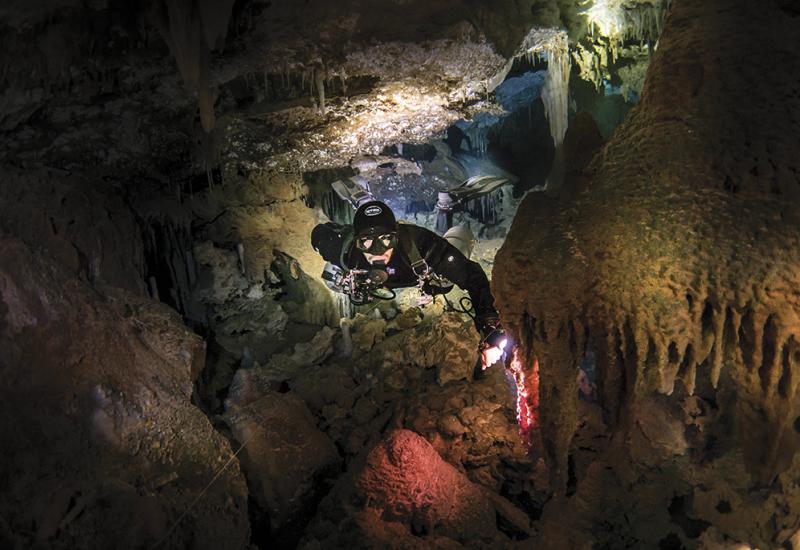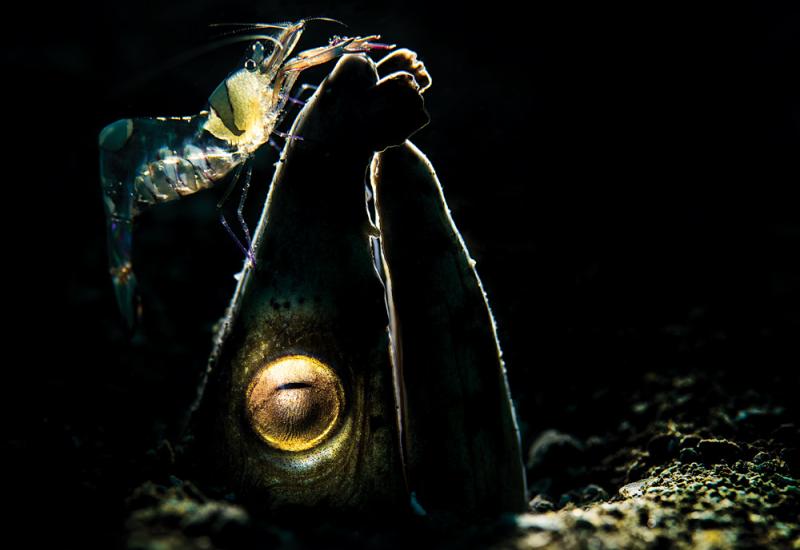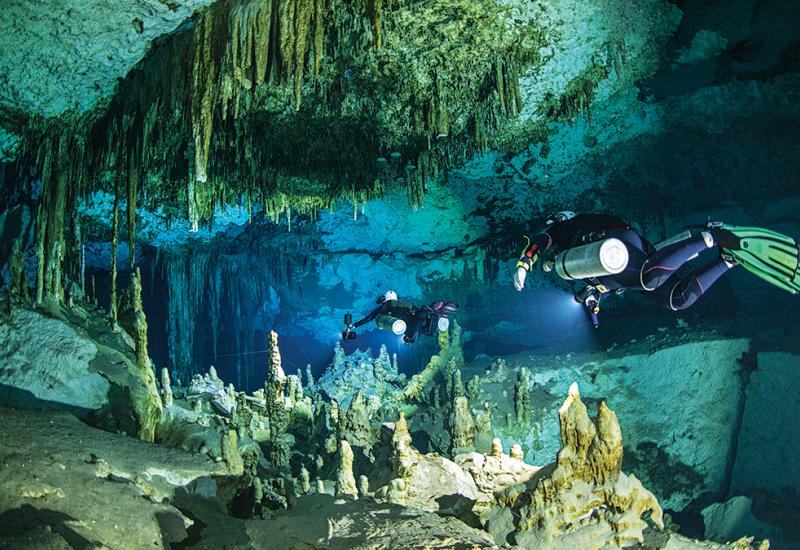Beneath the Jungle
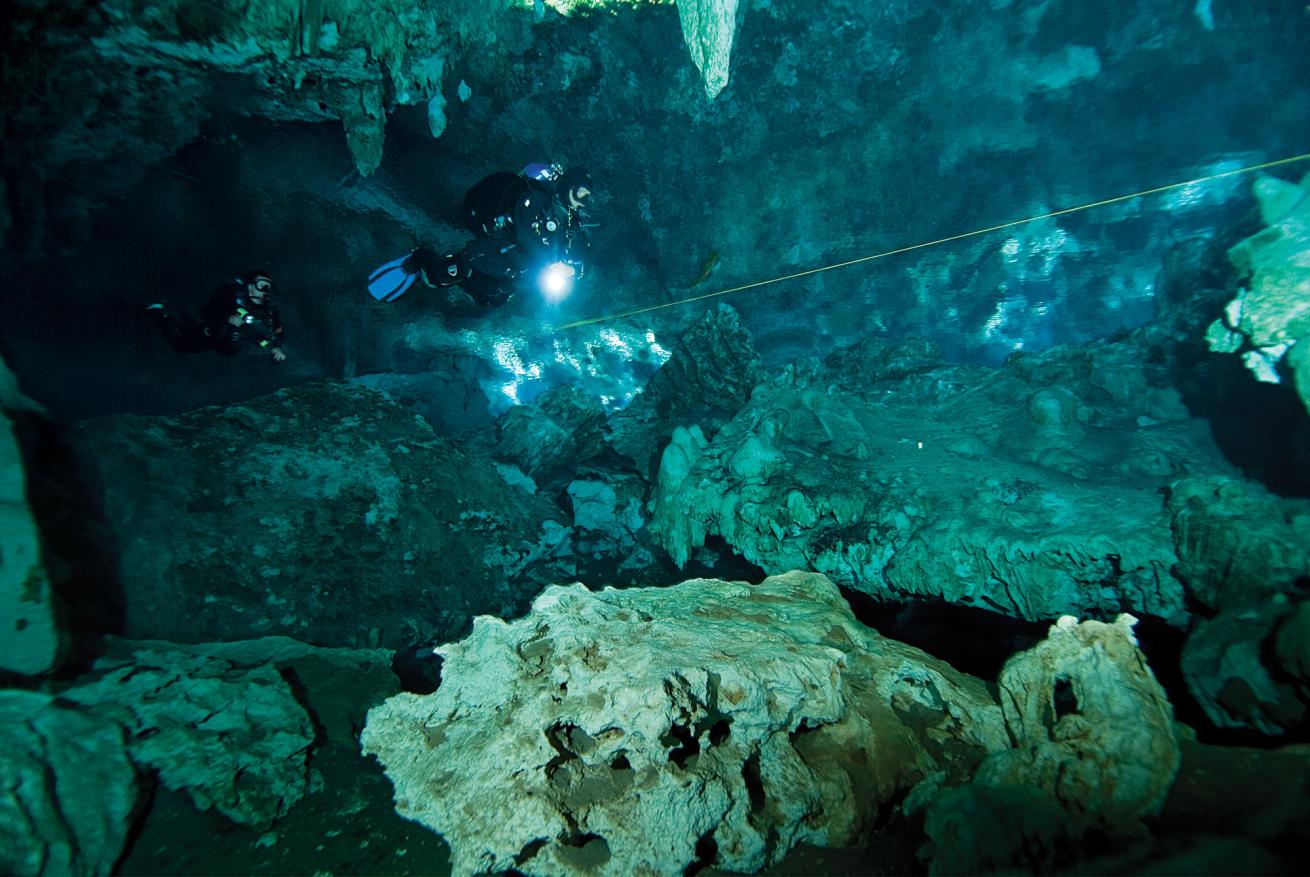
Belted into the passenger seat of a four-door pickup, the bed full of air tanks and dive gear, I’m rolling down a narrow stretch of paved road that cuts through a buzzing, sticky swath of Yucatan jungle listening to my dive guide, Nat Wilson, explain the mythology behind the freshwater-filled caverns we’ve been diving for the past couple of days. He’s just finished the part about how the ancient Maya believed the openings of these cenotes served as portals to Xibalba, the Mayan underworld, when he hits the brakes and swerves to the shoulder. “You see that?” he says, reaching across me, his outstretched finger pointing out my side window. “What?” I ask, “The jungle?” “Through this hole in the trees. See its tail?” I look harder — fairly impressed that he could spot anything through the dense underbrush — and I see it, a blue bird about the size of a pigeon with a twitchy tail that looks like it’s not properly attached to its body. “That’s the motmot,” he says, adding that the Maya considered motmots to be the guardians of the cenotes. “In reality, they hang around the caverns because it’s the only access to fresh water out here,” Wilson says. “And these days us cave divers watch for the birds to help us find the entrances.” Of course Wilson — the training director and in-house cave guru for Dressel Divers — doesn’t need a motmot to help him find the cenote we plan to dive. Though there are dozens of cenotes open to divers, one of the most popular is the Dos Ojos system — the name means “two eyes” and refers to the two primary cavern openings, called the “East” and “West” Eyes, which when seen from afar look like two eyes protruding from the jungle floor. And while this area is increasingly subjected to throngs of swimmers and snorkelers who splash around the entrances, Wilson assures me that deep inside the caverns it’s a whole different world. In order to get underwater before the tour buses from Playa del Carmen crowd us out, Wilson rolled up to the front of my beachside resort bright and early. Luckily I’m staying about midway between Playa and Tulum — in the heart of cenote country, not 15 minutes from Riviera Maya’s best dives — and when we show up, we have the place to ourselves. We park next to the trailhead that leads to the main entrance at the East Eye, strap on our gear and head down. I notice smoke billowing up from brush fires around the opening, and when I ask, Wilson explains that the locals, modern-day Maya who own the land around the cenote, build the fires as offerings to the gods. “Really?” I ask hesitantly. “Of course not,” he answers with a laugh. “They’re for the bugs.” I slap a handful of mosquitoes slurping from my ankle. Despite the bonfires, the mosquitoes are drinking their fill from our exposed feet and hands, so we make quick work of a back flop from the dive platform into the gin-clear water, do one final gear check and descend to the floor of the pool, where two guidelines are tied off at the mouth of the cavern. The right guideline, called the Barbie Line, follows an easy, well-lit path. On the left, the Bat Cave Line extends 65 feet into the opening of the submerged cavern before hanging a left into a darkened side passage. We take the latter. Wilson assumes the lead, hovering skillfully a couple of feet above the line to avoid stirring up the bottom, and I frog-kick gently to keep pace as we slip into the dark passageway, flashlight beams bouncing off the stark-white limestone formations — thick floor-to-ceiling columns and hanging stalactites that formed eons ago before these tunnels filled with water. After swimming a few minutes, we make another left turn into a large chamber, where a narrow beam of light coming through a small hole in the distance provides dim illumination while we follow the contours of the wall. From here, we follow the guideline as it slopes upward, leading us into the dive’s eponymous feature: the bat cave, another large, circular chamber, this one only partially filled with water, leaving an open-air space in the top of the room. Bearing left, we circumnavigate a jumbled pile of rock slabs, which had fallen from the ceiling to create a mesalike mound in the center of the room. Along the circumference, we explore a fissure beneath the limestone that constitutes the jungle floor 40 feet or so above our heads. And meandering through the tight maze of stalactites and stalagmites, we pass underneath some of the most delicate formations I’ve seen in any of my dives through these cenotes. Huge swaths of the ceiling bristle with soda-straw stalactites — pencil-thin protrusions that blanket the surface en masse like a bed of nails. At the far end of the chamber, Wilson stops and motions me to the surface of the water, tinged green by sunlight from a small opening in the roof. Popping up into the air pocket, I remove my regulator and take a breath of the cool, damp air. True to its name, the ceiling of the cavern boasts clusters of small bats; occasionally one swan dives from its upside-down perch and — wings spread — glides over the electric-green pool only to arc upward and alight once again. Eventually we drop back down and continue around the other side of the room, following the line back the way we came and emerging along the edge of the West Eye. Here, our guideline runs into itself at the passageway back to our starting point. We take it slow and hold our lights to our chests; from this vantage point, the sunlight filtering through the main entrance puts the whole cavern in silhouette, and “laser beams” of light stream in along the edges, bouncing off the pillars and formations that line the mouth of the cavern like fangs. After we climb the steps of the dive platform, Wilson starts back up the trail, but I hesitate for a moment, looking back over my shoulder. And just as I’m about to turn and leave, I see it again: the small blue bird, tail bouncing disjointedly, perched on the lip of the cavern as if overseeing our departure.
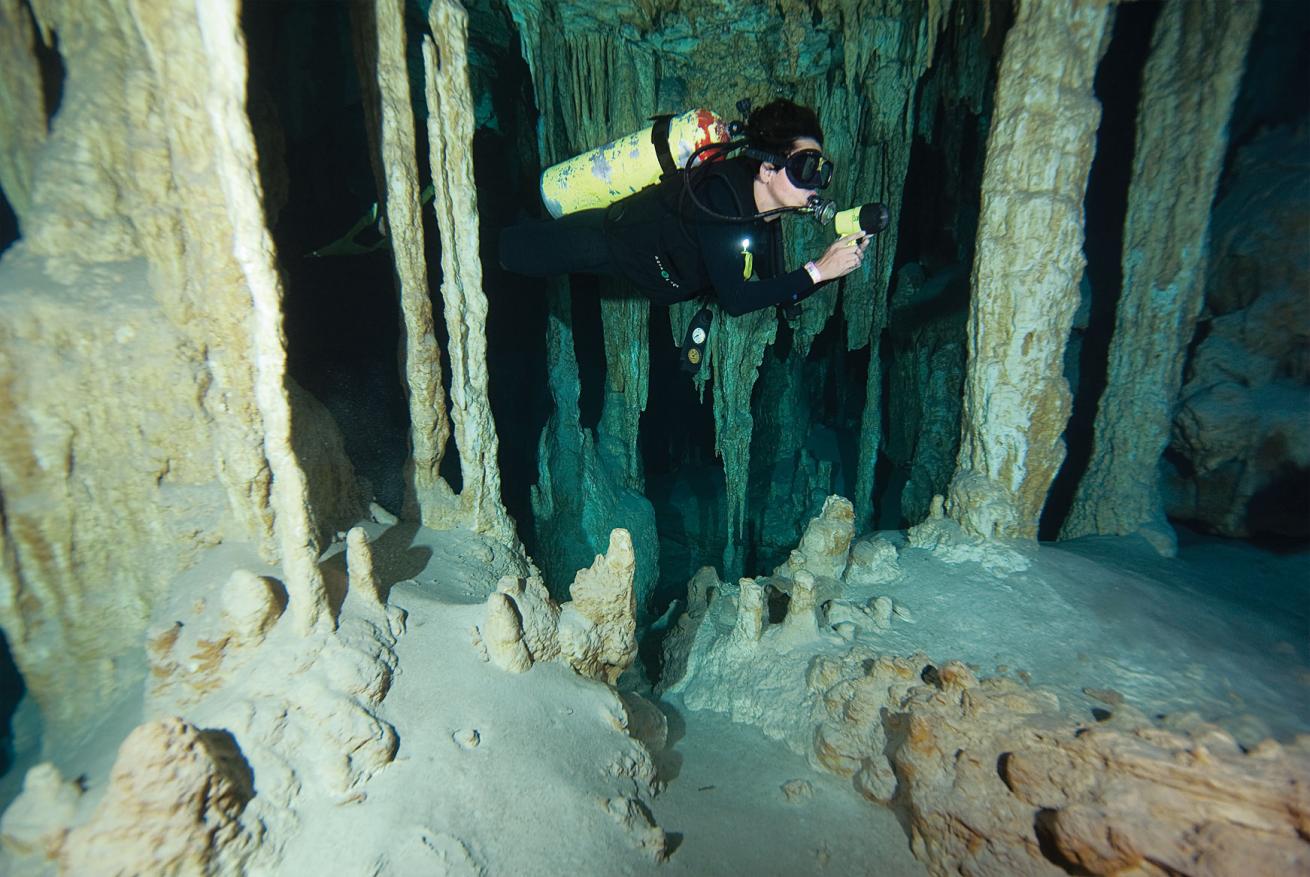
Top Dives:
The Bat Cave Line While this route is technically still a “cavern” dive that passes potential exit points in the course of the dive, the Bat Cave Line is one of the more-advanced cenote dives in the area. The dive traverses narrow, darkened tunnels and circumnavigates a pair of feature-rich chambers, the second of which has an open-air space at the top in which divers can surface in a dimly lit room where bats hang from the ceiling. If you’re traveling with a less-experienced diver, he or she can still join you on the dive. The Barbie Line runs from the same main entrance at the east eye down a wide passage, exploring the long, open space beneath the west eye. The line stays near the entrances for most of the dive, making it perfect for those who aren’t comfortable in more-traditional overhead environments.
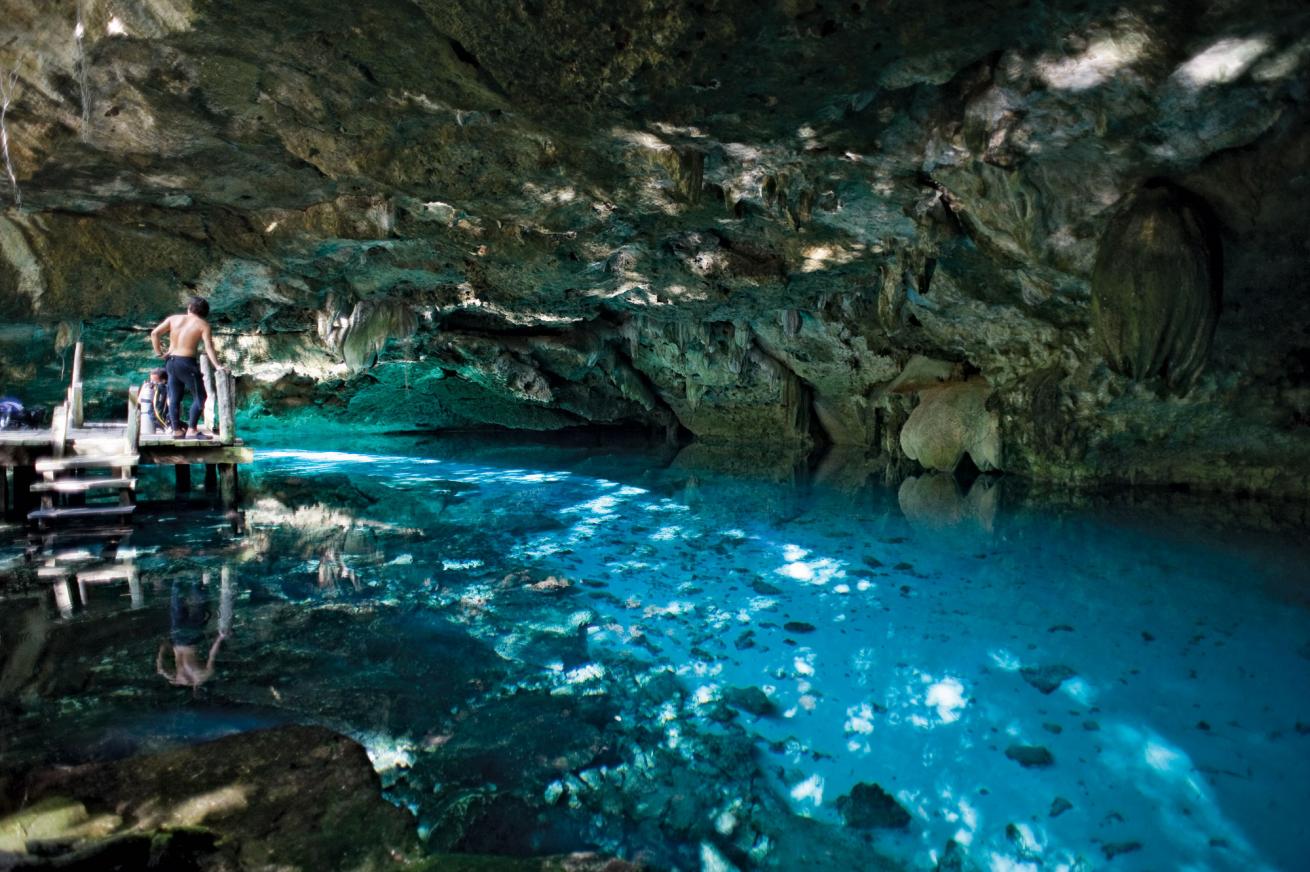
What It Takes:
Cenote dives in Riviera Maya stay within the “cavern” designated sections of the cave systems, meaning divers are never more than 200 linear feet from the surface, and Riviera Maya dive authorities allow recreational divers to enter the cavern-designated parts of the cenotes as long as they are with a cave-certified guide and as long as they follow cavern-diving procedures. No specific certifications are prerequisite, but dive centers do require a checkout dive in the ocean to evaluate your buoyancy and skill before diving the caverns. All divers get a lesson in cavern-diving procedures, including the rule of thirds, flashlight communication and out-of-air procedures for overhead environments. Consider taking a cavern-diver specialty course before arriving in Riviera Maya, or better yet, take the class on location and do your training dives in the cenotes.
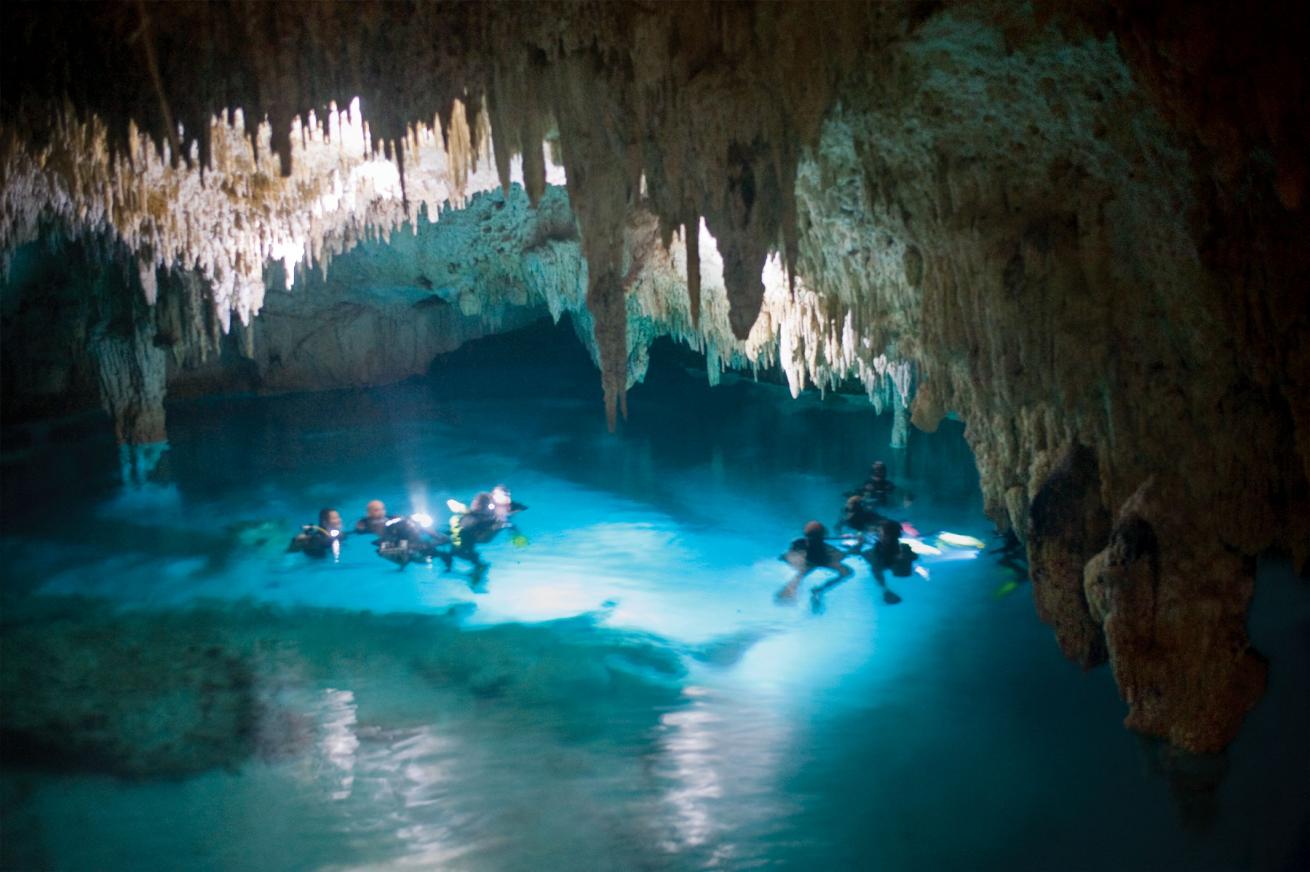
Need to Know:
Getting There The majority of Riviera Maya’s divable cenotes are off the main highway between Playa del Carmen and Tulum. Most American airlines route through major U.S. hubs to Cancun, which is the gateway to the Mayan Riviera. From the airport you can drive, take a taxi or hop a colectivo (shared van) for the 60- to 80-minute drive down the coast. When to Go Water temperatures (75-77°F) and calm dive conditions are constant year-round. The Yucatan’s high season runs from December through April, offering slightly cooler air temperatures and less rain. The rainy (low) season stretches from May to November, and during this time many resorts offer reduced off-season rates. Operator/Accommodations The Barcelo Maya Palace (www.barcelomayapalace.com) is part of the Barcelo Maya complex, which sports five amenity-rich all-inclusive resorts of varying price points stretched along nearly a mile of white-sand beach. Barcelo Maya is ideally located within a 10- to 20-minute drive of many of the Riviera Maya’s most popular cenotes. Arrange your dives at the on-site PADI IDC center, Dressel Divers (www.dresseldivers.com), which has a multilingual staff and certified cave/cavern guides. Price Tag Rooms at the luxe Barcelo Maya Palace start at $170 per person, per night. These rates are all inclusive, and Dressel Divers can pick you up right at the resort. The excursion fee to the cenotes is $70, and includes entrance fees, lunch and light refreshments. Tanks are about $40, but you’ll get discounts for buying multiple fills. Can’t-Miss Topside Adventures For a day of structured fun in a theme-park environment, visit the ecological parks at Xel-Ha and Xcaret. At Tulum, visitors can explore one of the best-preserved coastal Mayan archeological sites, not to mention some of the region’s nicest beaches. (Tip: Visit the ruins early to beat the tour-bus crowds — they open at 8 a.m.) And at the very southern border of the Mayan Riviera, the Sian Ka’an Biosphere Reserve — a UNESCO World Heritage Site — is a great place for nature lovers to explore tropical jungles and coastal mangroves.

